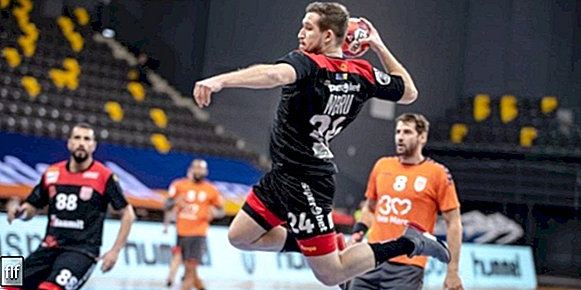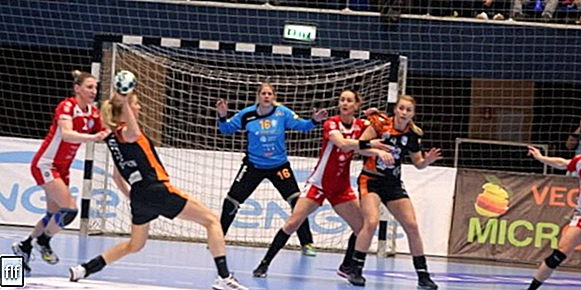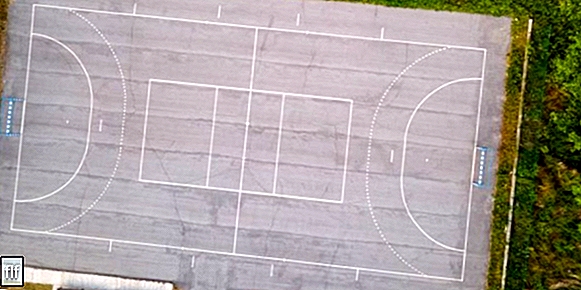- What is handball?
- history of handball
- Purpose of the game in handball
- Duration and result
- Handball court and positions
- Rules of the game in handball
We explain what handball is, what its court is like, rules and positions. In addition, we tell you its history and what is the objective of the game.

What is handball?
Handball, handball or handball is a sport in which two teams compete for control of an inflated ball, using their hands to control it and throw it into the opponent's goal, which is equivalent to scoring a goal. It is played both outdoors and indoors and each team is made up of around 7 people.
Handball is a widely practiced sport in Europe, with a rather minority presence in the rest of the world, with the exception of some American countries such as Brazil and Argentina, African countries such as Tunisia, Egypt and Algeria, and the only Asian exception of South Korea. There are both men's and women's professional leagues in these countries, and competitions national, regional and even global, organized by the International Handball Federation (IHF), based in Basel, Switzerland.
This sport should not be confused with wall handball, also called handball, wallball or 1-wall, a sport in which two players compete for control of a ball by bouncing it off a wall. In Anglo-Saxon speaking countries, it is common to refer to this sport as handball and handball like team handball or “team handball”.
history of handball
Handball has important antecedents in different games practiced in the ancient Greece and ancient Rome, such as the "Urania game" mentioned in the Odyssey of Homer, and of which pictorial murals were found in Athens in 1926.
However, the sport itself is very young and its first professional gaming groups emerged in central and northern Europe in the 20th century. At that time it was played in the likeness of the football, in teams of 11 players, as is still practiced in some European countries. Its creation is attributed to the professor of physical education German Karl Schelenz (1890-1956).
In 1926 he established the regulation international sport and in 1928 the International Amateur Handball Federation was founded during the IX Summer Olympics. This body later became the International Handball Federation, and in 1954 it organized its first world competition in the men's category, and three years later the first in the women's category.
In the 1960s, the practice of handball was approved by the International Olympic Committee, and from 1972 it was incorporated into the Olympic Games.
Purpose of the game in handball

The objective of handball is to score as many goals as possible, while preventing the opponent from doing the same. For this, the ball must be controlled most of the time and must be made to enter the opposing team's goal as many times as possible. At the end of the match, the team that has scored the most goals will be the winner.
Duration and result
A typical handball game lasts about an hour, divided into two periods of thirty minutes each. In the case of youth teams, this period can be shortened to 25 or 20 minutes per period. Between one period and another there is a mandatory rest period of 10 minutes.
At the end of this time, whoever has scored the most goals will be the winner. In the event of a tie, 5 more minutes of rest will be granted and then an extra time of two periods of 5 minutes each will be played, with a minute of rest between the two.If the tie continues, the procedure will be repeated. If there is no decisive result yet, the winning team will be determined by five successive throws of seven meters (7 m) per team, until a winner is found.
Handball court and positions

The typical handball court is 40 meters long and 20 meters wide (for 7 players, usually indoors) or 90-110 meters long and 55-65 meters long (for 11 players, usually outdoors).
The goals are usually 2 meters high and 3 meters wide, although in the 11-player version it can be even larger, and the goal line (which limits the closest point to the goal from which the ball can be thrown towards the arc) ranges between 6 and 13 meters away from the archery, depending on the version of the game.
Each goal is in the possession of a goalkeeper, trained to touch the ball with any part of the body and whose mission is to prevent the opposing goals. The other players, who can only touch the ball with their hands, are organized according to different positions:
- Central. Leading position within the construction of the play, which serves as the articulator of the team both in defense and attack. Normally he is the one who receives the ball from the goalkeeper to initiate the attack, and what is important, more than his strength and skill, is his ability to observe and plan the game.
- Extreme. Attack position, located on each side of the pitch, their mission is to slip into the opposing defenses, so they are usually agile, fast and lightweight players.
- Side. Goal-assist position, they are located on the sides of the center-back and are usually very tall, corpulent players with a powerful shot. They play a key role in defense.
- Pivot.Offensive position, equivalent to the striker in football, whose mission is to open spaces in the rival defense. They are usually robust players and skilled in close combat.
Rules of the game in handball
The rules of the game are simple: players must control the ball using only their hands and advance through passes and runs inside the opponent's court, until they achieve an advantageous position to throw the ball towards the goal. Only goalkeepers can use any part of the body to intercept the ball.
However, players in possession of the ball may only take three steps before making a pass or shooting towards goal. If you want to take more continuous steps you must bounce the ball off the ground. The game is fluid and is interrupted only when the referee so decides.
The contact between players is continuous and frequent, and it is allowed for the players to face each other face to face and obstruct the progress of the opponent, but at no time are they allowed to hit, push or attack each other. Players who act illegally can be sanctioned with a yellow card and 2 minutes offside; if sanctioned three times in the same match, the player must leave the match (red card).
